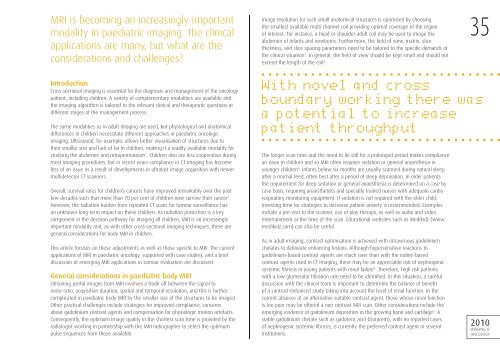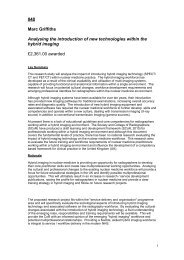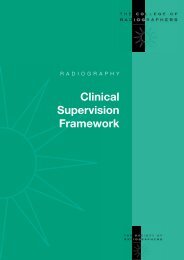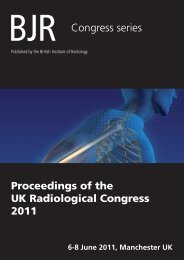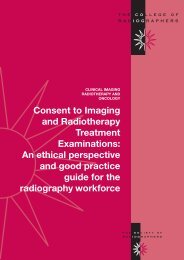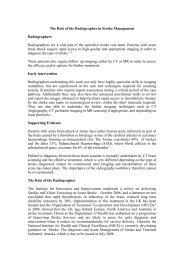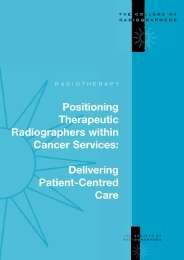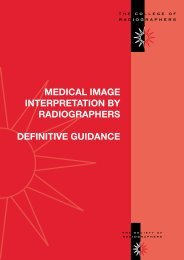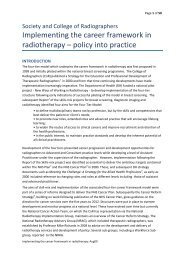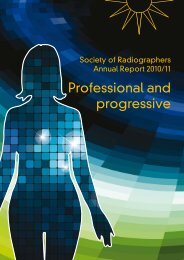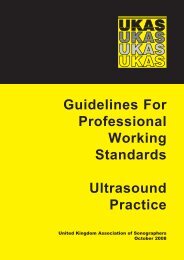IMAGING & ONCOLOGY - Society of Radiographers
IMAGING & ONCOLOGY - Society of Radiographers
IMAGING & ONCOLOGY - Society of Radiographers
- No tags were found...
Create successful ePaper yourself
Turn your PDF publications into a flip-book with our unique Google optimized e-Paper software.
MRI is becoming an increasingly importantmodality in paediatric imaging. The clinicalapplications are many, but what are theconsiderations and challenges?Image resolution for such small anatomical structures is optimised by choosingthe smallest available multi channel coil providing optimal coverage <strong>of</strong> the region<strong>of</strong> interest. For instance, a head or shoulder adult coil may be used to image theabdomen <strong>of</strong> infants and newborns. Furthermore, the fi eld <strong>of</strong> view, matrix, slicethickness, and slice spacing parameters need to be tailored to the specifi c demands <strong>of</strong>the clinical situation 1 . In general, the fi eld <strong>of</strong> view should be kept small and should notexceed the length <strong>of</strong> the coil 3 .35IntroductionCross sectional imaging is essential for the diagnosis and management <strong>of</strong> the oncologypatient, including children. A variety <strong>of</strong> complementary modalities are available andthe imaging algorithm is tailored to the relevant clinical and therapeutic questions atdifferent stages <strong>of</strong> the management process.The same modalities as in adult imaging are used, but physiological and anatomicaldifferences in children necessitate different approaches in paediatric oncologicimaging. Ultrasound, for example, allows better visualisation <strong>of</strong> structures due totheir smaller size and lack <strong>of</strong> fat in children, making it a readily available modality forstudying the abdomen and retroperitoneum 1 . Children also are less cooperative duringmost imaging procedures, but in recent years compliance in CT imaging has becomeless <strong>of</strong> an issue as a result <strong>of</strong> developments in ultrafast image acquisition with newermultidetector CT scanners.Overall, survival rates for children’s cancers have improved remarkably over the pastfew decades such that more than 70 per cent <strong>of</strong> children now survive their cancer 2 .However, the radiation burden from repeated CT scans for tumour surveillance hasan unknown long-term impact on these children. As radiation protection is a keycomponent in the decision pathway for imaging all children, MRI is an increasinglyimportant modality and, as with other cross-sectional imaging techniques, there aregeneral considerations for body MRI in children.This article focuses on these adjustments as well as those specifi c to MRI. The currentapplications <strong>of</strong> MRI in paediatric oncology, supported with case studies, and a briefdiscussion <strong>of</strong> emerging MRI applications in tumour evaluation are discussed.General considerations in paediatric body MRIObtaining useful images from MRI involves a trade <strong>of</strong>f between the signal tonoise ratio, acquisition duration, spatial and temporal resolution, and this is furthercomplicated in paediatric body MRI by the smaller size <strong>of</strong> the structures to be imaged.Other practical challenges include strategies for improved compliance, concernsabout gadolinium contrast agents and compensation for physiologic motion artefacts.Consequently, the optimum image quality in the shortest scan time is provided by theradiologist working in partnership with the MRI radiographer to select the optimumpulse sequences from those available.With novel and crossboundary working there wasa potential to increasepatient throughputThe longer scan time and the need to lie still for a prolonged period makes compliancean issue in children and so MRI <strong>of</strong>ten requires sedation or general anaesthesia inyounger children 4 . Infants below six months are usually scanned during natural sleepafter a normal feed, <strong>of</strong>ten best after a period <strong>of</strong> sleep deprivation. In older patientsthe requirement for deep sedation or general anaesthesia is determined on a case bycase basis, requiring anaesthetists and specially trained nurses with adequate cardiorespiratory monitoring equipment. If sedation is not required with the older child,investing time for strategies to decrease patient anxiety is recommended. Examplesinclude a pre-visit to the scanner, use <strong>of</strong> play therapy, as well as audio and videoentertainment at the time <strong>of</strong> the scan. Educational websites such as Medikidz (www.medikidz.com) can also be useful.As in adult imaging, contrast optimisation is achieved with intravenous gadoliniumchelates to delineate enhancing lesions. Although hypersensitive reactions togadolinium-based contrast agents are much rarer than with the iodine-basedcontrast agents used in CT imaging, there may be an appreciable risk <strong>of</strong> nephrogenicsystemic fi brosis in young patients with renal failure 5 . Therefore, high risk patientswith a low glomerular fi ltration rate need to be identifi ed. In this situation, a carefuldiscussion with the clinical team is important to determine the balance <strong>of</strong> benefi tpf a contrast-enhanced study taking into account the level <strong>of</strong> renal function. In thecurrent absence <strong>of</strong> an alternative suitable contrast agent, those whose renal functionis too poor may be <strong>of</strong>fered a non contrast MRI scan. Other considerations include theemerging evidence <strong>of</strong> gadolinium deposition in the growing bone and cartilage 6 . Astable gadolinium chelate such as gadoteric acid (Dotarem), with no reported cases<strong>of</strong> nephrogenic systemic fi brosis, is currently the preferred contrast agent in severalinstitutions.2010<strong>IMAGING</strong> &<strong>ONCOLOGY</strong>


